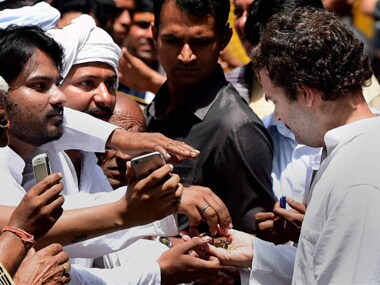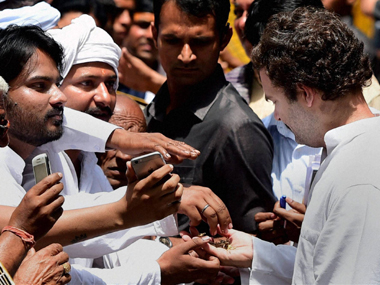Who can blame Trinamool MP Derek O’Brien for rolling his eyes? “All the Opposition parties blocked the real estate bill and sent it to the select committee – we are amused that one person is trying to hog the limelight,” O’Brien said. That “one person” of course is Rahul Gandhi who just met middle class homebuyers to listen to their woes. [caption id=“attachment_2226996” align=“alignleft” width=“380”]  Rahul Gandhi during a meeting with farmers. PTI image[/caption] O’Brien has a right to sound a little miffed. His party leader had just scored a thumping victory in the Bengal municipal elections. Even though Opposition parties cried foul, Mamata proved that her political obituary had been written way too prematurely. But the big story in media is about how “Rahul finds his mojo.” It’s amusing because Rahul has nothing concrete to show for his lost-and-found mojo yet. Mamata, at least can brandish those municipal poll results. Rahul meanwhile keeps “coming of age” like a teenager. OpIndia.com notes Rahul Gandhi has been coming of age for a long long time in 2009 in The Hindu, in 2010 on IBNLive, 2011 on NDTV and 2014 on BBC. Now India Today says “the transformation is nothing short of stunning for his followers and his critics.” The main proof of this “stunning transformation” is a five-point roadmap that India Today reveals for how Rahul wants to revive the Congress. They all sound perfectly commonsensical but if we just pause to think, it’s clear why there are miles to go before they can become reality. (Read the full story here.) He will travel across the country to take on the BJP government on issues that concern farmers, labourers and working class. India Today suggests that the bottom line for Rahul is simple: “create a class conflict between the rich and the poor”. But that would mean the poor have to feel that they were better off under UPA reign than under NDA rule. That’s easier said than done. “Nobody understand better the flaws of Nehruvian socialism than the poor. Those who are forced to rely on the State for schools, healthcare, electricity and clean water. They know that these are areas in which Nehruvian socialism failed abysmally,” writes Tavleen Singh in Indian Express. Even more problematic for Rahul’s gameplan, Narendra Modi has no intention of ceding any ground there. Singh, in fact, castigates Modi of putting the mute button on “parivartan” and “vikas” talk and says “(i)nstead he has taken to talking about ‘the poor’ in much the same way as Congress leaders always have.” All of Rahul’s hyperactivity begs the question as to whether he is a long distance runner. Sagarika Ghose puts it pithily in The Times of India “public life is a 24×7 treadmill and there’s a danger of burnout if those used to slow jogging begin to sprint too quickly.” He will instruct party workers to hit the streets with protests on every possible issue in states where they are not in power. Rahul himself is nervous about putting all his eggs in one basket. Hence after meeting with the kisans, and piping up for net neutrality, he quickly moved on to meeting with the middle-class homebuyers like a man armed with a checklist. Given that the number of states where the Congress is not in power is increasing by every election, Congress workers will be wearing the soles of their shoes quite thin if they have to keep hitting the streets everywhere. It already failed to live up to this action item in its revival plan in West Bengal where bitter enemies, BJP and CPIM, both came together to piggyback on a recent transport union strike to protest the municipal elections. The Congress, after vacillating, decided to do nothing. The problem for the Congress is that outfits in the states have been demoralized by a meddling top-heavy central leadership and resurgent regional parties. In Bengal it’s a shadow of its former self because the Trinamool has poached from it relentlessly anyway. He will revamp the party organization in states and induct “genuine ideologically driven” members. Revamping is well-overdue. The Congress, from Indira Gandhi’s time, is notorious for clipping the wings of state satraps who it deems as getting too big for their boots. That’s why ambitious state leaders from Mamata Banerjee to Pranab Mukherjee to P. Chidambaram have periodically left the party because the dynasty-bound party has a glass ceiling they could never breach. According to India Today, Rahul is serious about giving state leaders a “free hand and enough time to perform and deliver”. But this is a deep-rooted rot in the party where sycophancy has always been the key to survival and pliant state leaders have been rewarded. To now look for “genuine ideologically driven” members will mean the party has to take a long hard look in the mirror and ask itself what its ideology is anymore. India Today suggests it will include correcting mistakes like “overt Muslim appeasement” but it’s interesting to see whether Rahul has the stomach to even appear to alienate what it thinks is a vote bank. One Kedarnath visit won’t do it. He will appoint new state presidents and induct young leaders into the AICC. This is the periodic reinvention of the Congress and one hears it like clockwork every few years. There has been endless talk about the generational divide in the Congress but what Congress has is not an age problem but a connectivity problem. The Congress already has a young leader in Rahul. That he still lost the young/aspirational vote to the much-older Modi is a problem that just stuffing a new guard in an old bottle will not fix. 86-year-old Motilal Vora might step down as party treasurer but the Indian voter does not really care about that. Many of its young stars are themselves dynastic politicians and hardly poster boys for a meritocratic party. He will join social media to connect directly with the youth. The Congress has been careful to say no time frame has been set for this when in fact, this is one action item that Rahul could do immediately in five minutes flat. His social media reticence is emblematic of Rahul’s all-around hesitation when it comes to connecting directly with people. Having grown up inside a bubble, unlike a Modi, he is genuinely uncomfortable with the cut and thrust of retail politics. At this point social media is a tricky gamble for him. He sets himself up for easy comparison to Narendra Modi who is miles ahead of him in this regard. The problem is for Rahul now joining social media becomes an “event” and subject to immediate #Pappu scrutiny. It is the Congress party’s misfortune that it has in Rahul a leader who merits extended analysis just for doing what any senior party leader is meant to do – meet ordinary people, give speeches in parliament, go on padayatras, issue statements. The obvious comparison excited party workers are making is to Rahul’s father and grandmother who also travelled around the country after crushing electoral defeats in 1977 and 1989 to get back in touch with people and party workers. But Rahul has a problem that neither Indira nor Rajiv Gandhi had. They had not acquired the reputation of being dilettante leaders who disappeared for weeks (or months) on end. Electoral victories come and ago but living down that MIA-reputation will be Rahul Gandhi’s biggest challenge. That’s where he will have to win over people like his own great aunt Nayantara Sehgal who told India Abroad that the “big mistake” Sonia Gandhi made was to “push forward Rahul who is a dead loss as a leader.” “Let him do party work,” said Sehgal. “The Congress must make its own decision about that, put Rahul aside and get on with electing a leader who is capable of leading.” Now the Vipassana-improved Rahul might have a five-point strategy to lead but like the Congress’ famous five-year plans it could never go beyond the page if he does not himself turn over a new leaf and stick with the plan.
The five point plan for the revival of Rahul Gandhi’s fortunes may not be as easy to implement.
Advertisement
End of Article


)
)
)
)
)
)
)
)
)



